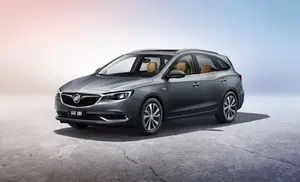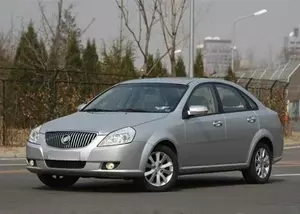


| Engine | 0—60 mph | 0—100 km/h | Top Speed | Averange Economy |
|---|---|---|---|---|
| 15S | 11.6 s | 12.2 s | 115 mph | 40 mpg |
| 20T | 8.4 s | 8.8 s | 127 mph | 41 mpg |
| Engine | 15S |
|---|---|
| 0—60 mph | 11.6 s |
| 0—100 km/h | 12.2 s |
| Top Speed | 115 mph |
| Averange Economy | 40 mpg |
| Engine | 20T |
| 0—60 mph | 8.4 s |
| 0—100 km/h | 8.8 s |
| Top Speed | 127 mph |
| Averange Economy | 41 mpg |
In 2018, Buick Excelle 0-60 acceleration was between 8.4 and 11.6 seconds.
Buick Excelle 0-60 mph was up to 22% slower in 2018 than world's average.
In 2018, Buick Excelle 0-60 mph to car weight ratio is shown below:
| Vehicle | Acceleration 0—60 mph (0—100 km/h) | Maximum speed | Acceleration to passenger ratio | Fuel consumption at high speed | Fuel type / gearbox |
|---|---|---|---|---|---|
| 15S | 11.6 s to 60 mph (12.2 s to 100 km/h) | 115 mph (185 km/h) | 2.3 s to 60 mph / person | - | Petrol (Gasoline) |
| 20T | 8.4 s to 60 mph (8.8 s to 100 km/h) | 127 mph (205 km/h) | 1.7 s to 60 mph / person | - | Petrol (Gasoline) / 7 DCG |
| Vehicle | 15S |
|---|---|
| Acceleration 0-60 mph (0-100 km/h) | 11.6 s to 60 mph (12.2 s to 100 km/h) |
| Maximum speed | 115 mph (185 km/h) |
| Acceleration to passenger ratio | 2.3 s to 60 mph / person |
| Fuel consumption at high speed | - |
| Fuel type / gearbox | Petrol (Gasoline) |
| Vehicle | 20T |
| Acceleration 0-60 mph (0-100 km/h) | 8.4 s to 60 mph (8.8 s to 100 km/h) |
| Maximum speed | 127 mph (205 km/h) |
| Acceleration to passenger ratio | 1.7 s to 60 mph / person |
| Fuel consumption at high speed | - |
| Fuel type / gearbox | Petrol (Gasoline) / 7 DCG |

| Engine | 0—60 mph | 0—100 km/h | Top Speed | Averange Economy |
|---|---|---|---|---|
| 1.6i R4 16V | 10.2 s | 10.7 s | 116 mph | - |
| 1.8i R4 16V | 10.2 s | 10.7 s | 121 mph | 28 mpg |
| Engine | 1.6i R4 16V |
|---|---|
| 0—60 mph | 10.2 s |
| 0—100 km/h | 10.7 s |
| Top Speed | 116 mph |
| Averange Economy | - |
| Engine | 1.8i R4 16V |
| 0—60 mph | 10.2 s |
| 0—100 km/h | 10.7 s |
| Top Speed | 121 mph |
| Averange Economy | 28 mpg |
In 2005, Buick Excelle 0-60 acceleration was between 10.2 and 10.2 seconds.
Buick Excelle 0-60 mph was up to 7% slower in 2005 than world's average.
In 2005, Buick Excelle 0-60 mph to car weight ratio is shown below:
| Vehicle | Acceleration 0—60 mph (0—100 km/h) | Maximum speed | Acceleration to passenger ratio | Fuel consumption at high speed | Fuel type / gearbox |
|---|---|---|---|---|---|
| 1.6i R4 16V | 10.2 s to 60 mph (10.7 s to 100 km/h) | 116 mph (187 km/h) | 2 s to 60 mph / person | 39 mpg (6 L per 100 km) | Petrol (Gasoline) |
| 1.8i R4 16V | 10.2 s to 60 mph (10.7 s to 100 km/h) | 121 mph (194 km/h) | 2 s to 60 mph / person | 39 mpg (6 L per 100 km) | Petrol (Gasoline) |
| Vehicle | 1.6i R4 16V |
|---|---|
| Acceleration 0-60 mph (0-100 km/h) | 10.2 s to 60 mph (10.7 s to 100 km/h) |
| Maximum speed | 116 mph (187 km/h) |
| Acceleration to passenger ratio | 2 s to 60 mph / person |
| Fuel consumption at high speed | 39 mpg (6 L per 100 km) |
| Fuel type / gearbox | Petrol (Gasoline) |
| Vehicle | 1.8i R4 16V |
| Acceleration 0-60 mph (0-100 km/h) | 10.2 s to 60 mph (10.7 s to 100 km/h) |
| Maximum speed | 121 mph (194 km/h) |
| Acceleration to passenger ratio | 2 s to 60 mph / person |
| Fuel consumption at high speed | 39 mpg (6 L per 100 km) |
| Fuel type / gearbox | Petrol (Gasoline) |